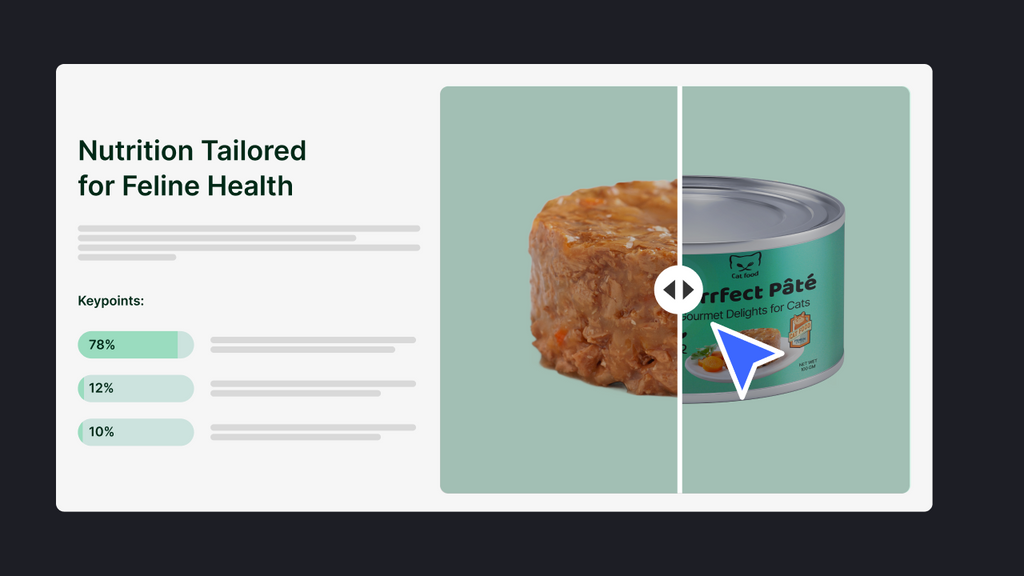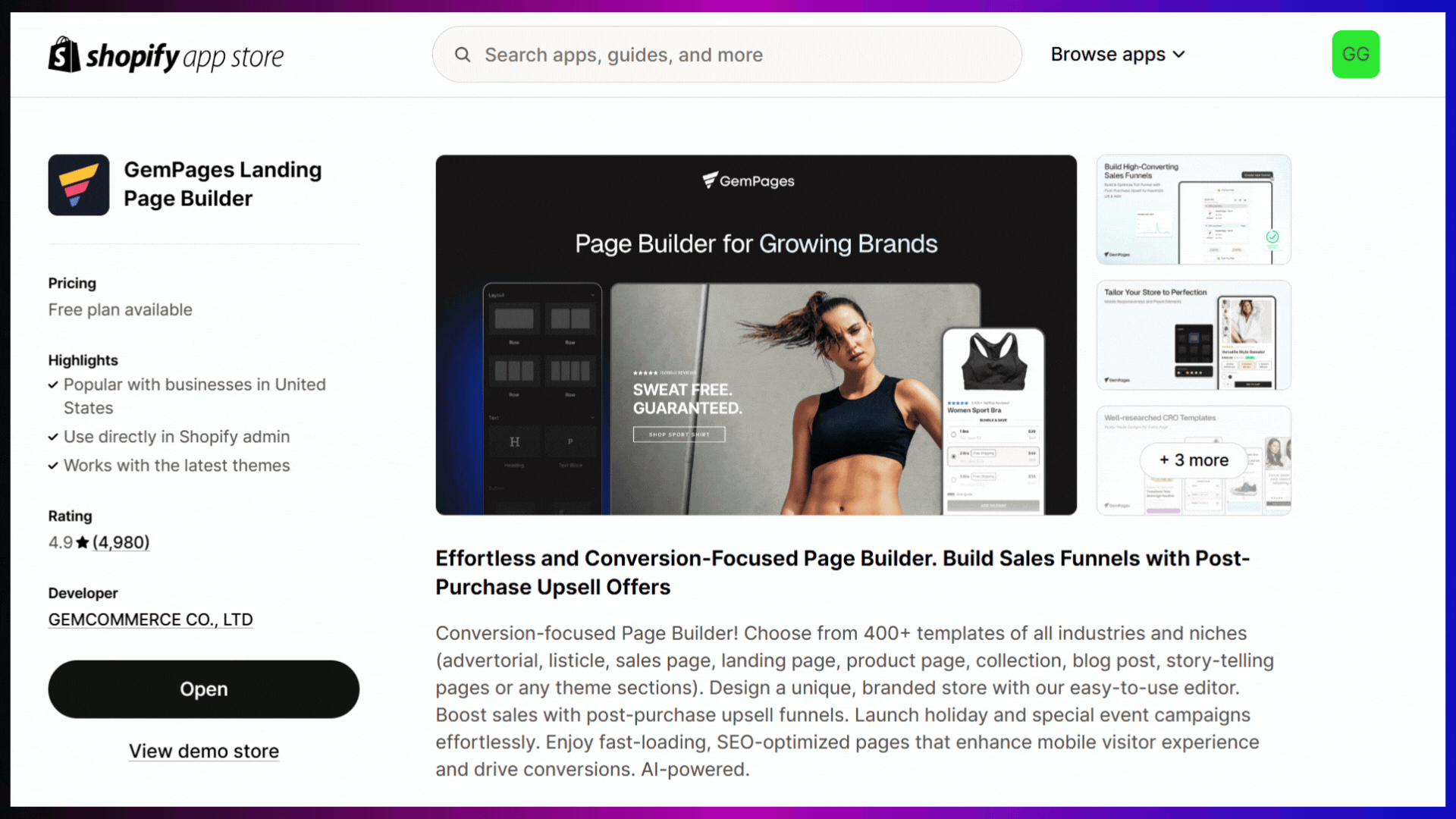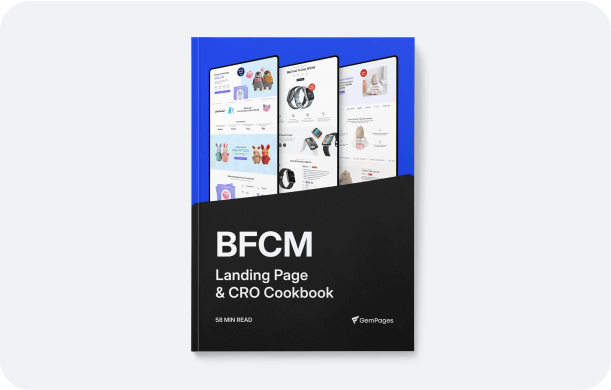- What is Interactive Website Design?
- Why Build an Interactive Website Design?
-
How To Build An Interactive Website on Shopify
- 1. Install an Interactive Shopify Theme
- 2. Use an Advanced Page Builder App
- 3. Add Animations & 3D Elements
- 4. Create Parallax Website Design
- 5. Connect Social Media Elements
- 6. Use Images and Videos
- 7. Use Interactive Discount + Brand Story Popups
- 8. Build an Interactive Quiz
- 9. Use a Chat Widget
- 10. Incorporate Audio Sound Effects
- 11. Showcase Visuals with GIFs
- Interactive Website Examples
- Create an Interactive eCommerce Store Design Now!
- FAQs About Interactive Website Design
How to Build an Interactive Website Design + Examples [2025]

Website visitors are hard to earn — and keeping them on your website is even harder.
Imagine you spending all the money on marketing and advertising — only to find out your website visitors are not engaging with your brand, content, or products. Agonizing, right?
An interactive website design can help:
-
engage those visitors with an immersive experience,
-
guide them through the buying journey,
-
entice them to take an action,
-
and convert them into your buyers (and even make them brand loyalists).
So, in this blog post, we’ll help you with a detailed guide on how to build an interactive website design for your Shopify store. Plus, we’ll share some awesome interactive website examples.
Let’s get started!
What is Interactive Website Design?
First off, by default, all eCommerce websites are interactive.
For example, you input commands like clicking on the collection or hitting the “Add to Cart” or “Buy Now” button to proceed to checkout — all those are interactions with the website. Basic stuff, right?
However, in the modern eCommerce website design trends, interactive website design (also known as immersive website design) has become more advanced — and stylish as well.
An interactive website design is a design style where visitors are enticed and encouraged to interact with the website — using design and content elements such as background themes, images, videos, animations, carousels, popups, quizzes, sound effects, and so on.
Of course, you may not need to use ALL these elements together. However, you can pick and combine multiple elements. These elements create a flow of interactions that can be synced with each other or function separately on their own.
Drunk Elephant — one of the popular skincare brands — is a great example of an eCommerce store with an interactive website design. The brand uses various elements to create an immersive experience such as a carousel, videos, and social media integration.

Why Build an Interactive Website Design?
The goal is simple — create interactions with the website visitors.
Now, let’s see the benefits of interactive website design to understand how you can leverage it for your business:
-
Enhance engagement with your visitors: As an eCommerce business owner, you want your customers to engage with your brand — and the interactive website design helps you create those engagements.
-
Convey your brand story or message: You can use the interactive website design to immerse customers into your brand story or deliver your message in a fun and engaging way.
-
Highlight your product in a unique way: The way you present your product to customers is crucial. The interactive elements can help showcase your product effectively.
-
Create a delightful shopping experience: Shopping on an online store doesn’t have to be boring. You can create a smooth and exciting shopping experience with the right use of interactive elements.
-
Increase your conversion rate: An interactive website design engages customers with its visual appeal and triggers. It drives users to take a certain action based on your desired goal(s), and thus, it can help you increase the conversion rate.
How To Build An Interactive Website on Shopify
There are multiple ways to create an interactive website design on Shopify. You can use a combination of tools and elements to create a stunning website.
1. Install an Interactive Shopify Theme
Shopify Theme Store is a library of 200+ free as well as paid themes. You can choose a theme that supports or has built-in interactive website design elements.
For example, Motion is one of the themes you may consider for interactive store design.
It’s quite a popular Shopify theme with over 500 reviews, and what’s even more amazing is that Motion has 97% positive reviews.

Motion allows you to create smooth animations throughout your Shopify store. It also has some other features such as image galleries, before/after image slider, image hotspot, slideshow, image zoom, etc.
Here’s one more interactive Shopify theme that you may consider:
Flow — a Shopify theme with 90% positive reviews from a total of 316 reviews.

2. Use an Advanced Page Builder App
Installing an interactive Shopify theme is just one of the steps. You can take your interactive website design to the next level with a page builder app like GemPages.
With an impressive rating of 4.9 out of 5 stars from close to 5,000 reviews, GemPages is a Shopify app trusted by thousands of merchants worldwide.

GemPages can help you create an interactive Shopify store design with its advanced features, professionally designed templates, and several design sections and elements.
The Interaction Feature by GemPages
What’s more exciting is that GemPages has recently launched the Interaction feature.
Interactions refer to actions performed by customers on a live page, such as hovering over an element, clicking on it, or when the page is loaded and causing changes in other elements.
Let’s take a brief overview of what’s possible with the Interaction features:
2.1 Dynamic Page Design Based on Product Quantity
Entice customers to buy more from your brand by displaying a discount or free shipping offer. This Interaction can help increase your average order value (AOV).
2.2 Custom Content Based on Variant Selection
Change the page content or color scheme based on the specific variant selected by the customer. This element can help make your page design more visually appealing.
2.3 Custom Carousel Navigation for Mobile:
Create smooth carousel navigation on mobile devices which is quite important for mobile user experience (UX). Thus, it can help increase the mobile conversion rate.
Check the demo here! (Check it out on mobile)
2.4 Upsell Popup:
Recommend relevant products for upselling and cross-selling through a popup.
Here’s a demo of this use case:
2.5 Urgency Element for Last-Minute Deals:
Create a sense of urgency with a timer and notification for the last-minute deal.
These are only a few use cases of the Interaction feature. Check out more details in the below article.
Learn more: Introducing New Feature: Interaction - a Tool For Maximum Engagement and Conversion
3. Add Animations & 3D Elements
Adding animations to your website design can help you make it more interactive as well as visually appealing. Most importantly, animations are great elements for building creative storytelling.
For example, let’s say you want to tell your brand’s story. Instead of just presenting it through texts and static images, you can create an animation flow that takes customers through the story with motion animation.
You can use a Shopify app like Canvify to create animations if you need an easy solution. Or if you want, you can also use custom code like the one shown in this example on Codepen — Airplanes.

Apart from the web design, you can also use 3D product images to help users review products from different angles.
4. Create Parallax Website Design
Parallax website design can enhance your website’s interactive design and make it more visually appealing. But you may ask: What is parallax website design?
Parallax website design or scrolling effect is a web design technique where a webpage is designed with different layers — background and foreground — that move at different speeds to create a sense of 3D experience for website visitors.
Again, you have two options to create a parallax website design on your Shopify store:
-
Use a parallax-focused Shopify theme
-
Use GemPages’ parallax design element
GemPages has an easy-to-use visual editor that makes the design process smooth even if you don’t have web design experience. Just drag and drop the sections and elements to customize your interactive website design.

Learn more: Parallax Website Design: Creating a Parallax Scrolling Effect
5. Connect Social Media Elements
Social media channels can also be a crucial element in making your eCommerce store more interactive. For example, you can add an interactive social media feed on your website.
Also, there are other ways to connect social media with your eCommerce store. For example, you can allow customers to directly share your products on their social media accounts using a share button. The same can be implemented on your blog as well.
We’ve already seen the Drunk Elephant’s website as an example of an interactive design. The brand also uses interactive elements like videos and social media.

6. Use Images and Videos
Almost all eCommerce brands use images and videos on their website, right?
But the thing is — it’s how you use them in your website design that matters. Images and videos are great for visual storytelling. You can leverage them to create an interactive website design.
Use images and videos in the background with a front layer of text or other design elements. It’s similar to what we discussed in the parallax website design.
Brickfielder — a men's polo shirt and golf clothing brand — is a fitting example that’s making brilliant use of video to create an immersive experience. The brand has placed this video right below the hero section and it highlights its product with style.
7. Use Interactive Discount + Brand Story Popups
Popups are also a great way to entice customers to interact with your website.
But here’s the issue: most brands have uninspiring popups that just display the percentage discount and simply ask customers to subscribe to it. You can add an element of your brand story to popups.
How? Alia — an email & SMS popup app — is a great solution for creating such a popup on your store. The app is already gaining quick popularity among many Shopify stores.

THIS POPUP IS MY FAVORITE. And our popups are live on over 500 sites.
— Shaan Arora (@iamshaanarora) December 16, 2024
Absolute dream come true to work with this brand and founder.@AlexNeist @HostageTape
Wait till the end of the vid👇🏽 pic.twitter.com/AO3RBeMGrE
How to Grow Your Shopify Email List with Website Popups?
The Best Website Popup Examples that Help You Drive Conversion
8. Build an Interactive Quiz
Quizzes are quite helpful not only to engage with your website visitors but also to learn more about them. On top of that, you can also leverage those customer insights through a quiz funnel.
The idea is to ask a set of questions to customers and offer product recommendations or any other incentive for participating in the quiz. Here are the different types of quizzes you can create on your Shopify store:
-
Product recommendations quiz
-
Discount gamification quiz
-
Assessment & guidance quiz
Learn more: Shopify Quiz Funnel — Guide, Examples, and Apps
9. Use a Chat Widget
Using a chat widget is also a way of making your website interactive.
Offering live chat can make the customer experience so much better as customers can interact with your chat agents to resolve their queries.
You can also use chatbots to address some frequently asked questions but allowing customers to reach out to human support makes it more impactful.
Shopify App Store has many apps that can help you add a live chat widget to your store.
10. Incorporate Audio Sound Effects
So, we discussed about the visual storytelling that can create an immersive experience for your website visitors. On top of that, adding audio sound effects can enhance visual storytelling to a whole new level.
But you might be wondering — how do I add audio or background music to my Shopify store?
Well, like any other solution, there are many Shopify apps that can help you achieve this. Go to the Shopify app store and search the keyword “audio” or “background music” and you’ll find plenty of awesome apps.
11. Showcase Visuals with GIFs
Static images are good for most pictures. But when you want to showcase something in action, static images cannot help much.
You either need a video or a GIF. When the demo is of just a few seconds, you can use GIFs (instead of a video) to show the product in action with a quick visual.
We’ll see an example of this in the next section where Nuka displays a great example of how to use GIFs for a stunning interactive website.
Interactive Website Examples
1. Nuka.me
Nuka.me not only offers a unique product but also impresses you with a unique website design. Nuka’s interactive website design engages you to explore the product with great visuals.

The brand uses visual storytelling with images, GIFs, and parallax effects on its homepage.
2. Mrs. Meyer's
Mrs. Meyer's Clean Day is a brand that offers eco-friendly household cleaners, made with plant-derived ingredients. The brand has created an interactive website design with background graphics in product images.

3. Red Rooster Coffee
Red Rooster is a coffee brand that has won many awards for its high-quality product. The brand also aims to make a positive social impact with various initiatives such as offering healthcare benefits to employees and contributing to local charities and fundraisers.
Talking of the interactive website design, the brand uses interactive elements on product listings and testimonials.

Create an Interactive eCommerce Store Design Now!
Customers want to learn about your brand and product before purchasing from you.
This exploration needs to be captivating. You can use interactive website design to tell your brand’s story and put your product in the limelight.
But keep in mind — customers are looking for a seamless experience too. When using interactive design elements, make sure they don’t negatively impact the UX, site speed, and overall performance.
If you haven’t already, install GemPages now — and start building your interactive eCommerce store.
To learn more about eCommerce marketing strategies and best practices, check out more resources on the GemPages Blog. Join the GemPages Facebook community to network and learn from like-minded entrepreneurs and experts.



 Facebook Community
Facebook Community Change Log
Change Log Help Center
Help Center












